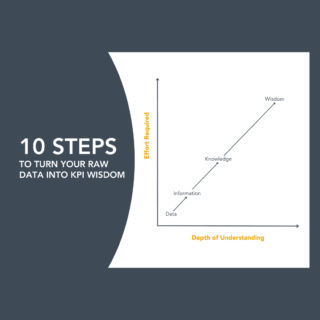Scorecard, scoreboard, strategy framework, performance management, strategy maps: common terms which can easily be misunderstood, misused, and confused. So, let’s get some clarity when it comes to the Balanced Scorecard; not in detail, but with the purpose of helping you know when it might be a useful framework for what you want to accomplish, and when it likely won’t (and another method or tool would probably be a better fit).
Balanced Scorecard: What is it?
In short, the Balanced Scorecard is a strategy management system designed to help your organization set, track, and achieve key business strategies and objectives. Its strength is the structure it provides to translate the sometimes-vague hopes of a company’s vision and mission into the practicalities of managing the business better at every level.
Two Harvard professors, Kaplan and Norton, developed the Balanced Scorecard in the 1990s. They recognized that most organizations tended to rely solely on tangible financial measures as an indicator of how they were performing. Financial measures are necessary, but they are lagging indicators that only reveal what happened in the past. They provide little indication of what might happen in the future. They also noted from their research that many organizations failed to fully execute on their strategy and rarely achieved the needed change and improvement required.
To deal with these problems, the Balanced Scorecard empowers leaders to develop objectives within four critical perspectives of (or ways of looking at) your organization.
The most common Scorecard perspectives that create the “balanced” view of an organization are:
- Financial: keeps focus on your financial health
- Customer: keeps focus on your customers’ satisfaction and performance
- Business process (how the company gets things done): puts focus on those internal processes that are most likely to deliver value to your customer
- Learning & growth (and often assets): puts focus on the internal capabilities and organizational capacity you need to improve the processes that are customer critical.
The “scorecard” aspect comes in when an organization has measures for each one of the objectives that sit within the perspectives.
These four views are not simply a collection of independent objective sets. Rather, Kaplan and Norton wanted to reveal the logical connections between them. Telling a strategy story using perspectives reveals how improving learning and growth leads to better business processes, which in turn leads to increased value to the customer, which finally leads to improved financial performance. For those who love visuals, these relationships are shown with a technique called Strategy Mapping*. An important mapping adjustment occurs when we shift from a for-profit company to a not-for-profit. A for-profit company will have the financial perspective at the top of its map; a not-for-profit will bring the customer perspective to the top and place the financial perspective below it as it empowers how you deliver value to those you serve.
Balanced Scorecard: What it is not
Now that you have a high-level understanding for how the Balanced Scorecard might help inspire a disciplined approach to increase the likelihood of a successful strategy implementation, it is equally important for your organization to understand what it is NOT!
It does not help formulate a clear strategic direction
Organizations need an approach that structures courageous conversations and helps leaders set a focused strategic direction that articulates what they want to achieve in the future. Only then, can you bring in an execution framework (such as the Balanced Scorecard or OKRs) to help translate it to operational terms.
It does not help design meaningful performance measures (KPIs)
The Balanced Scorecard is often chosen by executive teams because they think it will help them have better measures, but this is just not true. It can help executives know WHAT to measure (the objectives) but does not help with HOW to measure quantifiably. Leaders will need a rigorous approach and likely improved capabilities that help them with their teams design strong and feasible measures that produce evidence over time and can statistically prove the achievement of their desired outcomes.
It does not help design a useful and useable “scorecard”
Like performance measures, leaders often assume that the Balanced Scorecard approach will lead to better performance reports or dashboards. Unfortunately, it rarely does. The reason is that, too often, organizations lack the know-how to develop reports that are truly useful and usable for evidence-based decision-making. A useful performance report shows leaders their progress towards strategy, and a usable report is quick and easy for leaders to interpret (and ensures interpretations are accurate).
In Summary, invest in learning and using the BSC framework when an organization wants a structured approach for creating improvement objectives that align to the vision and mission. These objectives, when done well, drive strategy execution and tell a story of what leaders need to achieve across four perspectives. It can help you decide what to measure; but don’t use it to improve how you measure.
To improve how you measure, your organization needs to invest in building skills and capabilities for:
- designing better quantified measures for what is most important to improve
- increasing buy-in to these measures; and,
- creating more useful and usable reports/dashboards that answer the 3 critical questions every performance report needs to answer using statistically sound visualizations.
Want to know what those 3 critical questions are?
Email us at hello@adurastrategy.com
Resources:
*What is strategy mapping using the Balanced Scorecard?
A strategy map is a visual representation of how your organization plans to deliver on its mandate and achieve its vision. It can be a powerful story-telling tool. Read more here:
https://adurastrategy.com/what-is-strategy-mapping-and-how-is-it-different-from-results-mapping/
Sources and Resources for reading:
• Robert S. Kaplan and David P. Norton, The Strategy-Focus Organization, 2001
• Harvard Business Review: Putting the Balanced Scorecard to Work (article: https://hbr.org/1993/09/putting-the-balanced-scorecard-to-work
• Balanced Scorecard for Dummies



